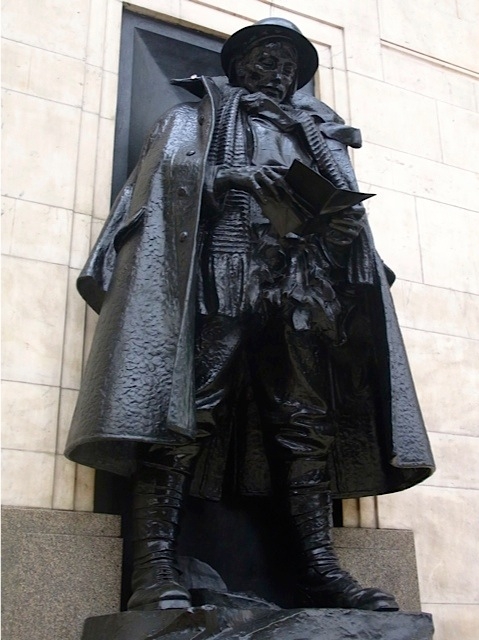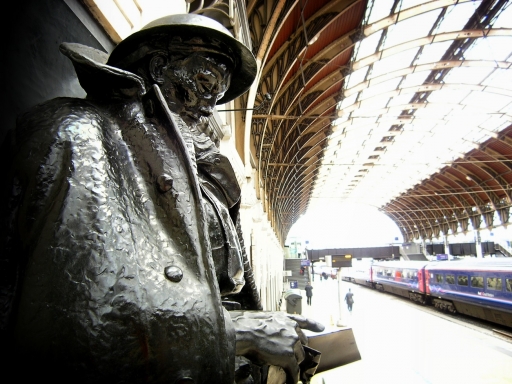People are being invited to join leading writers insendingletters to an Unknown Soldier to express their feelings about the First World War and be part ofCentenary memorial.
The letters will be collected and published on a website which was launched this week.
The idea is to provide a snapshot of the Centenary for future generations with a different kind of memorial.
The inspiration for the project is the Charles Jagger war memorial on Platform One of Paddington Station, London, which features a statue of an ordinary soldier in battle dress reading a letter.
Writers
Already more than 50 well-known writers have pledged to send a letter, including Stephen Fry, Geoff Dyer, A L Kennedy, Andrew Motion, Lee Child, Alan Hollinghurst, Deborah Levy, Andy McNab, Bonnie Greer, Esther Freud, Malorie Blackman, Sheila Hancock, Owen Sheers, Glenn Patterson, Caryl Churchill, Daljit Nagra, David Almond, Kamila Shamsie, Liz Lochhead and Sebastian Faulks. The latest to join is contemporary artist Bob and Roberta Smith.
The project has been created by Neil Bartlett and Kate Pullinger and commissioned by 14-18 NOW WW1 centenary commissions.
New conversation
In a statement, Neil, a novelist and theatre director, and Kate, a novelist and creative writing professor, said: This is everyones chance to be part of a new conversation about remembering the war and to have their voice heard.
Their letter will be published online alongside those of our commissioned letter writers and the entire collection will be added to the British Library archive at the end of the project.
2014 is already proving to be a year jammed-full of commemoration. For us, it is important to move away from the usual imagery. Wed like instead to hear what people think – what they really think – and for them to write a letter to the unknown soldier.
“If they were able to speak to him now, with all that has been learned since 1914, and with all their own experience to hand, what would they say?

A wide-range of people and groups have signed up. These include a choir in Derbyshire, writing groups in Derry, prisoners in Buckinghamshire, nurses in Hull, cookery groups at the Empire cafe in Glasgow, local historians in Monmouthshire, ex-service men and women in Plymouth, The University of the Third Age and schoolchildren nationwide.
Anna Vinegrad, project public relations officer, told Centenary News: The website is now open to receive the letters. There are a few letters on there but the vast bulk will not be published until June 28.
“That is when the website is fully live and that is when Neil and Katewill begin to create the memorial.
They will pull out themes and ideas that are coming through and feature particular letters. At the moment people can enter but they wont be able to see what they enter.
British Library
After June 28 it is 37 days until August 4 and that is when the memorial will be created and then it will be archived in the British Library. It would be great for readers of Centenary News to take part.”
Whilst UK based anyone aroundthe world can write a letter. A group of Gurkhas is getting involved in the project.
What is interesting is that it is really encouraging different viewpoints and that is already coming out in some of the letters I have seen and it is really quite distinct from a lot of the other commemorations, Anna said.
The project is already going round schools encouraging letters from children.
Teachers can download a pack to use in Creative Writing, English, History, Drama or Citizenship classes.
Anna said: On Monday I was at a school in Muswell Hill, north London, with year 8-10 year students and they wrote the most astonishing letters in the space of an hour.
Snapshot
They had been talking to their families and they turned up some incredible stories which were then woven into these letters. It was really inspiring and brilliant to see children of that age so engaged in the history of it.
It will be a great snapshot for future generations to be able to read these things.
Everyone can contribute their letter by visiting the websiteand entering it onto the site or sending it by Royal mail to LETTER TO AN UNKNOWN SOLDIER, PO Box 73102, London EC1P 1TY.
Picture courtesy of Letters to an Unknown Soldier.
Body text picture Peter Alhadeff
Posted by Mike Swain, Centenary News
